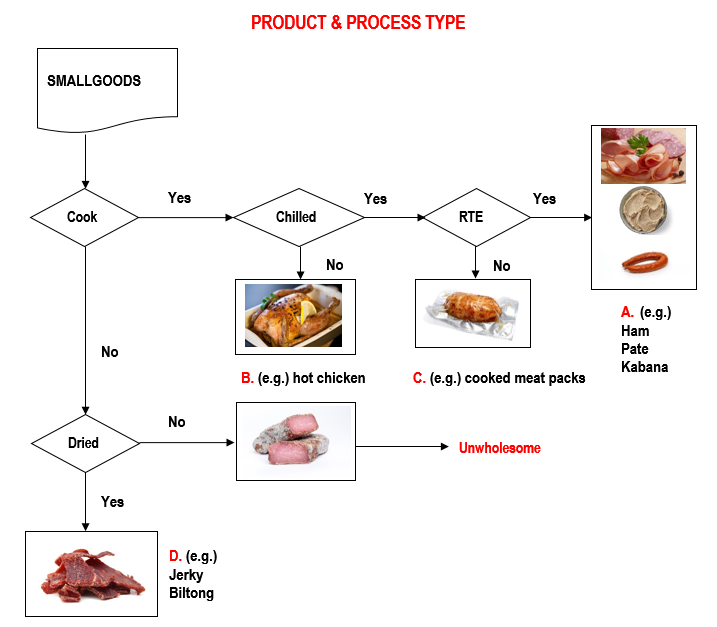Smallgoods PrimeSafe Technical Guideline
Learn about the requirements for processing, handling and labelling smallgoods.
Summary
- This is a guideline only. Be sure to understand the standards referred to by this guideline.
- Smallgoods are meat products that undergo cooking, cooling, curing, fermenting or drying processes.
- The food safety risks are high for smallgoods.
- PrimeSafe conducts more frequent audits for businesses that manufacture smallgoods.
About smallgoods
Smallgoods products can be stored either above 60°C, below 5°C, ambient or frozen. Smallgoods products may be eaten hot or cold as ready-to-eat (RTE) or heated prior to consumption.
Traditional processors of smallgoods in Australia initially came from Europe, predominantly from Italy and made products that could not be easily sourced from retail shops. As migrants from other ethnic regions of the Middle East and Asia began settling in Australia, the variety and manufacturing processes of smallgoods evolved. As the popularity and demand for smallgoods increased, the once artisan businesses expanded into today’s flourishing industry.
While artisan businesses remain, today’s manufacturing processes allow for large scale production. As a result of foodborne disease outbreaks in the 1990’s, Australia, along with other countries implemented food safety controls specifically for smallgoods. Although the manufacturing of smallgoods may vary between the different ethnic groups and in the scale of the meat processing facility, standards are applied exactly the same, with the consideration for food safety being paramount. Read more about smallgoods at the Meat and Livestock Australia website.
Requirements to manage food safety risks
The Food Standards Code Australia New Zealand (the Code) has defined some of the requirements for smallgoods. The requirements below highlight the key criteria for approval and manufacture of smallgoods in Victoria. The food safety regulatory requirements for uncooked comminuted fermented meat (UCFM) products have not been included in this guideline. All UCFM approvals are managed directly by PrimeSafe prior to commencement of production.
Summary of requirements
Facility construction
- Every facility that manufactures smallgoods must hold a PrimeSafe licence, except where the smallgoods will only be consumed at the place of production (e.g. restaurants).
- The licensee must apply in writing to PrimeSafe for approval to manufacture smallgoods.
- As part of considering the application, PrimeSafe will assess the facility’s compliance with the construction requirements described in the Australian Standard for the Hygienic Production and Transportation of Meat and Meat Products for Human Consumption (AS 4696).
Manufacturing processes
- The licensee must have an approved HACCP based Food Safety Program identifying the food safety hazards and controls.
- Raw meat products must be segregated from Ready-to-Eat (RTE) products.
- Cooked RTE smallgoods must have a core temperature of at least 65°C for 10 minutes and meet the requirements of AS 4696. Any alternative cooking processes must be validated and approved by PrimeSafe.
- The Cooling process must meet the requirements of AS 4696:
- uncured products must be reduced from 52°C to 12°C within 6 hours and reduced to 5°C within 24 hours of completion of cooking; or
- cured products must be reduced from 52°C to 12°C within 7.5 hours and reduced to 5°C within 24 hours of completion of cooking.
- Product must be stored and sold either below 5°C, above 60°C or ambient.
- Dried meat products must achieve a water activity of no higher than 0.85. This does not include slow cured dried meat.
- Any added preservatives must meet the requirements of Standard 1.3.1 Schedule 15, Section 8 of the Code.
- For cured products, the curing solution must be stored at or below 5°C.
Microbiological testing
- The Food Safety Program must include a Listeria Management Plan for each RTE meat product type that is processed and packaged with a shelf life of greater than five days.
- Testing of pathogenic bacteria as required by the Code for specific smallgoods products.
- Listeria monocytogenes testing as required by the Code, Standard 1.6.1, and the AMRG Regulatory Guidelines for the Management of Listeria.
Auditing
- Verification records must be maintained to meet the requirements of AS 4696 for the following processes:
- heat treatment (65°C or above for 10 minutes, or equivalent as approved by PrimeSafe); and
- cooling stage 1 (reduced from 52°C to 12°C with 7.5 hours for cured products, or 6 hours for uncured products); and
- cooling stage 2 (reduced to 5°C or below within 24 hours of completion of cooking).
- The Licensee must advise PrimeSafe in writing when the facility has ceased manufacturing smallgoods.
Auditing of smallgoods manufacturing processes
Due to the high food safety risk associated with smallgoods, businesses that manufacture smallgoods are audited more frequently. Businesses that package and repackage smallgoods have the same audit frequency as businesses that manufacture smallgoods. The likelihood of contamination with pathogenic bacteria such as Listeria monocytogenes is high during packaging and repackaging processes, especially if products are not cooked or heated completely again before consumption. A business that is no longer manufacturing smallgoods will be required to maintain the same audit frequency until the term of expiry of the licence. At renewal, a business must advise if they wish to manufacture smallgoods.
Testing of smallgoods, especially RTE products, is a critical step in ensuring that the final product is safe to eat through the successful elimination of the potentially pathogenic bacteria. Smallgoods must be tested according to the requirements described in the Code and the AMRG Guidelines for the Management of Listeria. The Code also has specified limits for some pathogenic bacteria prevalent in smallgoods such as packaged cooked cured/salted meat, packaged heat-treated meat paste, and packaged heat-treated meat pate, ready-to-eat meat products and UCFM.

Disclaimer
This information is a guide only and must not be used in place of the current Standard. PrimeSafe does not guarantee its accuracy, reliability, currency or completeness, therefore it cannot be used to substitute for legal or professional advice. PrimeSafe accepts no legal liability arising from reliance on any part of this document.